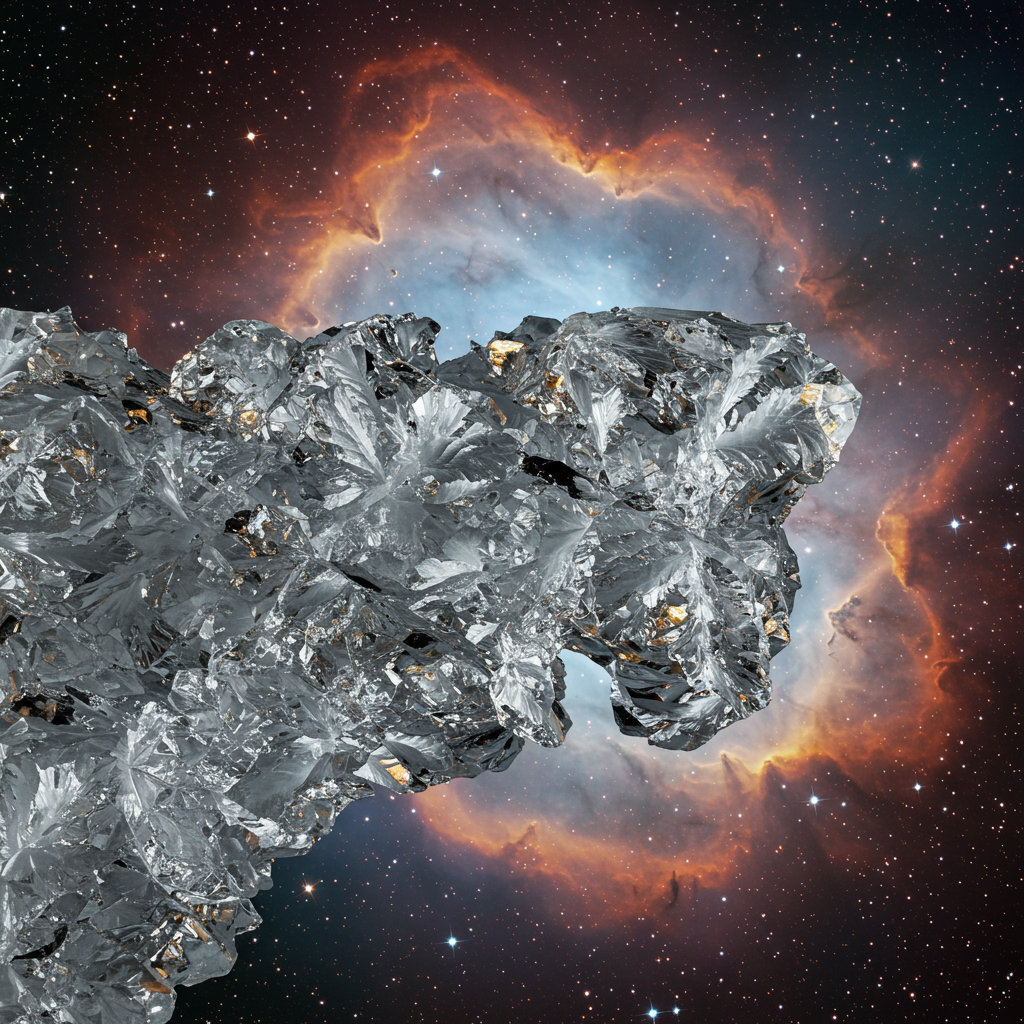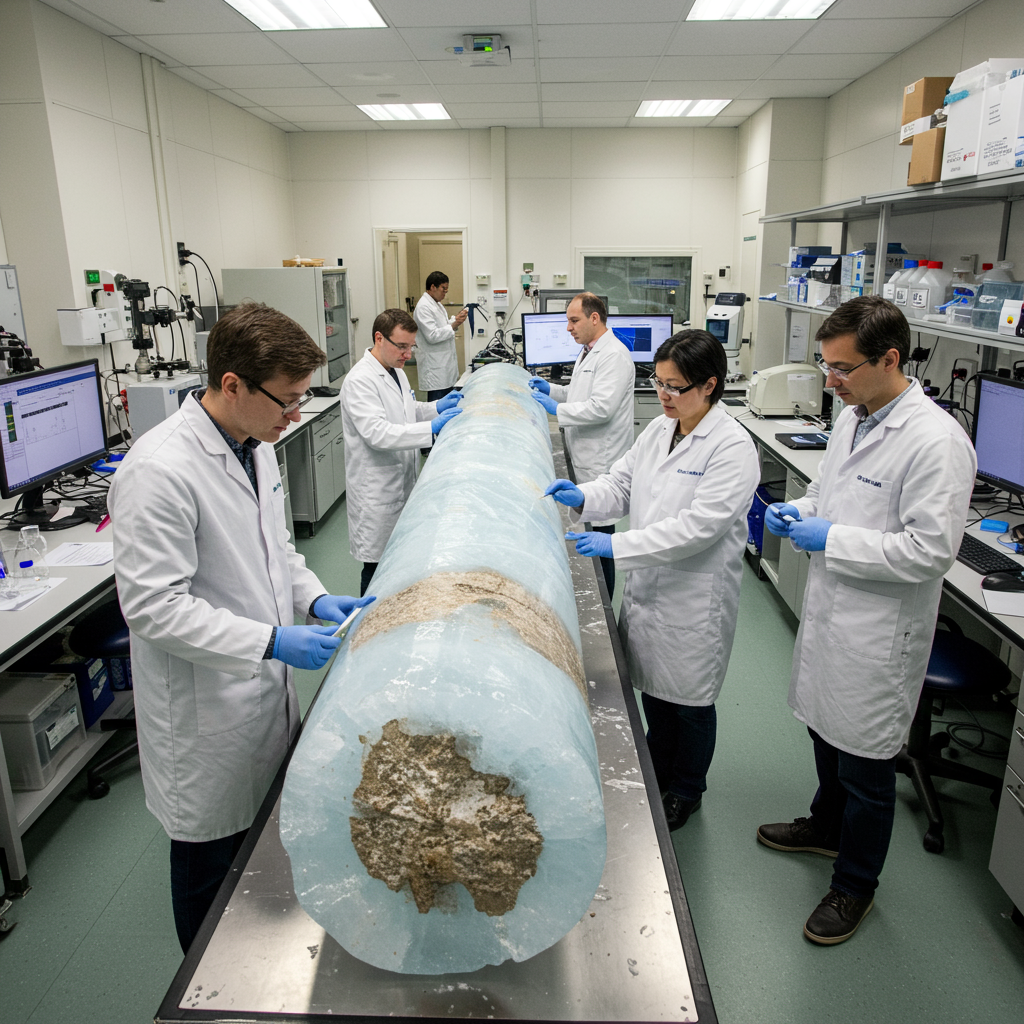For decades, scientists believed that the ice found throughout the vast, cold expanse of the universe was completely disordered, much like a snapshot of liquid water instantly frozen in place. This material, known as low-density <a href="https://news.quantosei.com/2025/07/09/space-ice-experiments-pour-cold-water-on-panspermia-origin-of-life-theories/” title=”Crucial Space Ice Study Challenges Panspermia Theory”>amorphous ice, blankets comets, coats icy moons, and forms in the frigid dust clouds where stars and planets are born. However, groundbreaking new research from University College London (UCL) and the University of Cambridge is challenging this long-held assumption. Their findings reveal that cosmic ice is far more complex than previously thought, containing tiny, hidden crystals embedded within its seemingly shapeless structure.
This surprising discovery significantly alters our understanding of one of the universe’s most abundant materials. It shows that even in the extreme cold of space, where energy levels are low, water molecules can arrange themselves into organized patterns. This revised view of space ice has profound implications, impacting theories ranging from the origins of life on Earth to the practical uses of ice in future space exploration.
The Longstanding Mystery of Cosmic Ice
Ice is a fundamental building block in the cosmos. On Earth, we typically see ice in its crystalline form, visible in the perfectly ordered structure of snowflakes or ice cubes. Its molecules are arranged in a repeating, symmetrical pattern. But in the extreme low temperatures and vacuum of space, scientists theorized that water vapor would freeze so rapidly onto cold surfaces (like dust grains) that its molecules wouldn’t have enough energy to snap into a neat crystalline lattice. The result was thought to be a disordered solid – amorphous ice.
This ‘amorphous’ state was considered the default for cosmic ice because the environment lacks the thermal energy needed for molecules to vibrate and find their ordered positions. Low-density amorphous ice, specifically, forms when water vapor is deposited onto extremely cold surfaces, mirroring how ice forms on interstellar dust. High-density amorphous ice exists too, formed under immense pressure at low temperatures. Until now, low-density amorphous ice was widely accepted as a completely disordered material, a frozen chaos of water molecules.
Hidden Order: Crystals Within the Amorphous State
The new study, led by Dr. Michael B. Davies and published in Physical Review B, combines sophisticated computer simulations with laboratory experiments to probe the true nature of low-density amorphous ice. The researchers found that the structure of this cosmic ice is not entirely random. Instead, it contains small crystalline regions dispersed throughout the amorphous matrix.
These tiny crystals are incredibly small, measuring only about three nanometers wide. To put that into perspective, this is just slightly wider than a single strand of human DNA. The presence of these ordered pockets within the disordered structure suggests that even in the deep freeze of space, water molecules manage to find some level of organization. This challenges the previous picture of space ice as simply a ‘frozen snapshot’ of liquid water.
Unlocking the Secret: Simulations and Experiments
How did the scientists uncover this hidden order? They used a two-pronged approach. First, they created detailed computer models that simulated boxes of water molecules freezing at extremely low temperatures, specifically around -120 degrees Celsius (-184 degrees Fahrenheit). By varying the rate at which the virtual water was cooled, they observed different outcomes in the solid structure. Some simulations produced mostly disordered ice, while others showed tiny crystals forming within the amorphous material.
Crucially, when the researchers compared the results of these simulations to data from previous experiments that used X-rays to study the structure of real amorphous ice samples, they found a match. The simulation results that best fit the experimental measurements were those where the ice was a mixture – approximately 20% crystalline material and 80% amorphous material. This provided strong computational evidence for the presence of nanocrystals.
The team then conducted experimental work on Earth. They created samples of amorphous ice in ways that mimic how it forms in space, such as depositing water vapor onto a super-chilled surface. They also worked with high-density amorphous ice. A key part of their experiment involved gently warming these amorphous ice samples. It is known that ice can retain a ‘memory’ of its previous structure, particularly in how its hydrogen atoms are arranged, even when in an amorphous state.
When the experimental ice samples were warmed and began to recrystallize, the final crystal structure varied depending on how the original amorphous ice had been formed. The researchers reasoned that if the ice had been completely disordered, it would have no ‘memory’ or imprint of its earlier form. The fact that the ice samples did retain a subtle structural memory suggested they must have contained some form of initial order – the tiny crystalline seeds. This experimental evidence supported the conclusions drawn from the computer simulations.
Why This Discovery Matters for the Cosmos
Understanding the precise structure of space ice is vital because ice plays a central role in countless cosmic processes. It’s not just inert material; it’s an active participant in the universe’s evolution.
This improved atomic-level picture of the most common form of ice helps scientists better model how planets form. Ice grains aggregate to form planetesimals, the building blocks of planets. Their structure and properties influence how they stick together and grow. It also impacts our understanding of how galaxies evolve and how matter moves throughout the universe, as ice is often a key component of the interstellar medium.
The findings also tie into broader questions about the composition of the outer solar system. Recent studies, for instance, suggest a revised early solar system chemistry with higher carbon abundance, which could explain why objects like Pluto contain more rock than predicted. Understanding the composition and structure of the ice within these bodies, as this new research provides, offers another piece of the puzzle for explaining the makeup of icy worlds.
Implications for the Origin of Life
One fascinating area affected by this research is the speculative theory of Panspermia. This idea suggests that the chemical building blocks of life, like simple amino acids, might have been delivered to early Earth on comets embedded within space ice. Low-density amorphous ice was considered an ideal ‘space shuttle’ material because its disordered structure was thought to have ample space to trap and protect these delicate molecules during their long journey.
However, Dr. Davies notes that the discovery of a partly crystalline structure introduces a complication. A structure that contains crystalline regions has less void space compared to a fully amorphous material. This means it might be a less efficient transport medium for embedding and protecting life’s precursors. The theory isn’t entirely ruled out, though, as the ice still contains significant amorphous regions where such molecules could potentially be trapped and stored. The discovery adds a new layer of complexity to this intriguing hypothesis.
Impact Beyond Astrophysics
The implications of this study extend beyond the cosmic realm. The research raises fundamental questions about amorphous materials in general. These materials, which lack long-range order, are critical components in many advanced technologies we use every day.
For example, the glass fibers that form the backbone of the internet and transport data over vast distances need to be amorphous for optimal function. If these materials contain tiny, undetected crystals, as the study suggests might be the case for seemingly amorphous ice, it could impact their performance. Understanding the presence and characteristics of these nanocrystals could open avenues for improving the performance of various amorphous materials used in modern technology. As Professor Christoph Salzmann points out, if tiny crystals exist in these materials and can be removed or controlled, it could lead to technological advancements.
Furthermore, knowing the properties of different ice forms is becoming increasingly important for future space exploration. Ice in space isn’t just scenery; it could be a valuable resource. Ice could potentially be used for radiation shielding on spacecraft or even as a source of fuel, broken down into hydrogen and oxygen. A detailed understanding of its structure and properties, including the presence of nanocrystals, is essential for utilizing cosmic ice effectively.
The Enduring Mystery of Water
This study also highlights how much we still have to learn about water itself. Despite being foundational to life, water is a substance with many peculiar properties or ‘anomalies.’ It exists in over 20 known solid forms under different temperatures and pressures. Scientists have been studying its amorphous forms, including low-density and high-density states discovered in the 20th century. Intriguingly, the same research team behind this study also discovered a new medium-density amorphous ice in 2023, which has the same density as liquid water.
Professor Angelos Michaelides suggests that amorphous ices may hold the key to explaining some of water’s many anomalies. The discovery that the most common form of cosmic ice is not purely amorphous, but contains hidden order, adds another fascinating twist to the complex story of water in the universe. The researchers acknowledge that their findings open up new questions, such as whether the size and distribution of the nanocrystals vary depending on how the amorphous ice was formed, and even whether a truly perfectly amorphous state for ice is physically attainable.
Frequently Asked Questions
What did the new study find about the structure of space ice?
The study found that the most common form of ice in the universe, low-density amorphous ice, is not completely disordered as previously believed. Researchers discovered that it contains tiny crystalline structures, about three nanometers wide, embedded within its otherwise amorphous (shapeless) arrangement. This hidden order changes the understanding of cosmic ice’s fundamental properties.
How did UCL and Cambridge researchers study cosmic ice?
The research team used a combination of computer simulations and laboratory experiments. They simulated water molecules freezing at extremely low temperatures and compared the results to existing data, finding that a structure with about 20% crystalline and 80% amorphous ice best matched observations. They also created real samples of amorphous ice in the lab and observed that when warmed, their recrystallization structure retained a ‘memory’ of their formation, indicating the presence of initial crystalline order.
Why is understanding the structure of space ice important for science?
Knowing the precise structure of space ice is crucial for several scientific fields. It improves models of planet formation, galaxy evolution, and how matter moves in space. It impacts theories about the origin of life (Panspermia), suggesting ice might be a less efficient carrier for life’s building blocks than thought. It also has implications for materials science, raising questions about amorphous materials in technology like fiber optics, and for future space missions that might use ice as a resource.
Conclusion
The universe’s most common form of ice, long thought to be a simple, disordered solid, is revealing itself to be far more intricate. The discovery of hidden nanocrystals within low-density amorphous ice by researchers at UCL and Cambridge challenges a fundamental assumption about water in the cosmos. This finding, backed by both computational modeling and experimental evidence, updates our understanding of the atomic structure of cosmic ice. It has significant implications for everything from how planets are built to the potential for life beyond Earth and the development of advanced materials here at home. As scientists continue to probe the nature of water in all its forms, this research underscores that even in the deepest chill of space, nature holds complex and surprising patterns waiting to be uncovered.
Word Count Check: 1191




